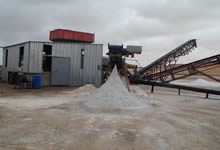 The region is famous for its mineral resources, notably phosphate, salt and sand. The phosphate mine of Boucraa, exploited by Phosboucraa company, is about 100 km to the southwest of Laayoune. This mineral is processed, in a first stage, before being sent to a factory in Laayoune Port via a 98.3 km conveyor system.
The region is famous for its mineral resources, notably phosphate, salt and sand. The phosphate mine of Boucraa, exploited by Phosboucraa company, is about 100 km to the southwest of Laayoune. This mineral is processed, in a first stage, before being sent to a factory in Laayoune Port via a 98.3 km conveyor system.
Phosphate undergoes several enriching processes (washing, drying and sorting) before being exported abroad. The Boucraa plant annually produces 1.860.000 tons of phosphate, representing 2.32% of the national production, employs about 2400 workers, and exports 45% of this production to the United States and 20% to southern European countries.
The region also has ten sabkhas (Arabic name for a salt-flat ordinarily found nearby sand dunes) which constitute great reserves of salt, but their exploitation is still traditional: filling basins with salty water, and after its evaporation there remains a salty layer that is gathered by shovel.
The most important sabkhas in the region are: Sabkhat Tazga, Oum Dbaa, Tisltin, and Tisfourin. They cover a large area, and the most important of them is Sabkhat Tazga-Tarfaya, whose reserves are estimated at 4.5 million tons and which is operating since 1991 by Somasel company. The region's salt production stands at about 20.000 tons a year, and provide more than 500 seasonal jobs.
It is essential to consider activities related to sand exploitation among mining activities. Sand production in the region reached in the year 1998 around 78.630 tons exported to Las Palmas/Canary Islands.